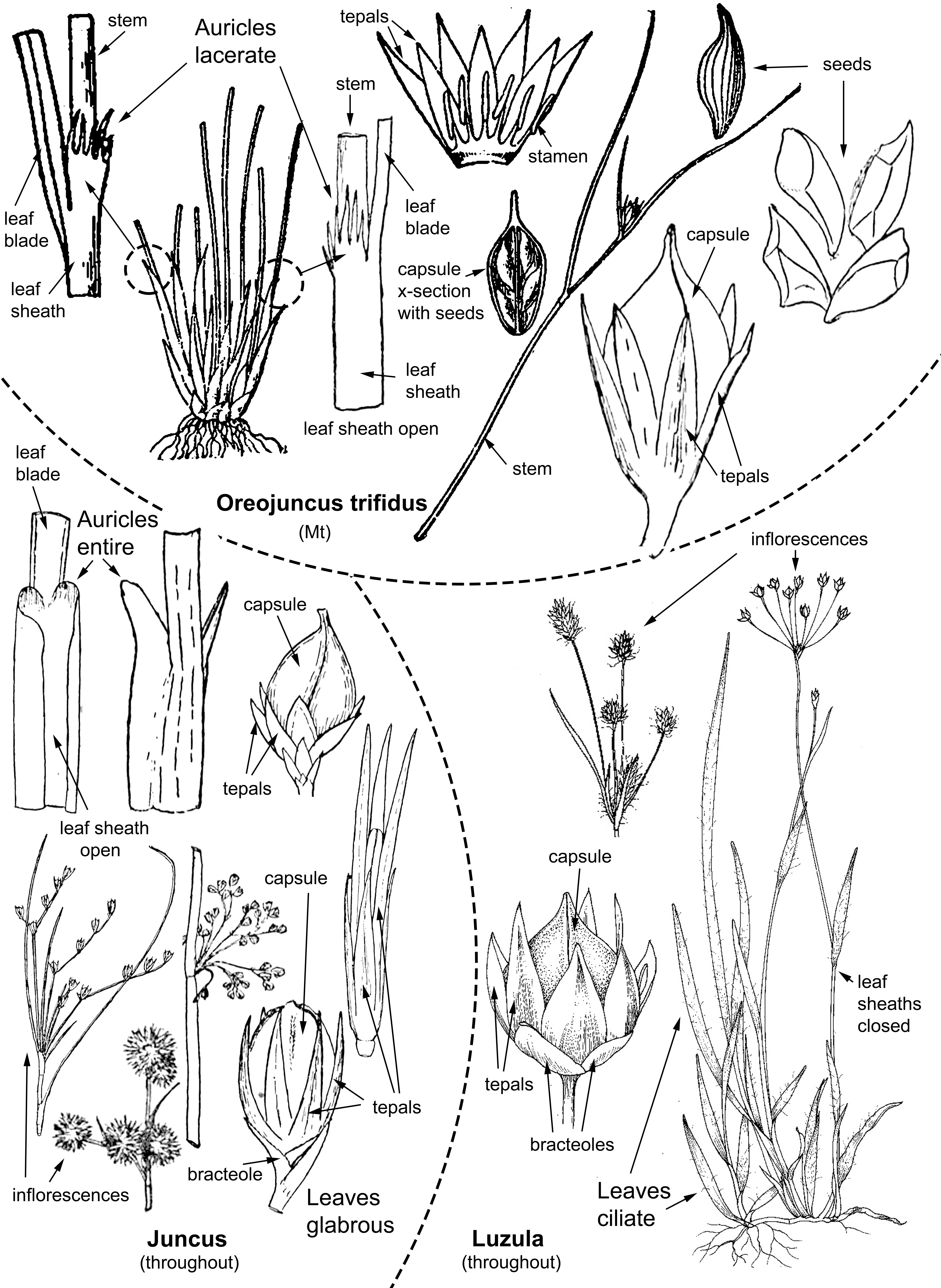
Rushes (Juncaceae) are represented by three genera in the Carolinas (Juncus, Luzula, and Oreojuncus) and include 40 species in the two states (Brooks & Clemants 2000; Swab 2000; Drápková & Kirschner 2013). The family is one of three "graminoid" families, the other two being the sedges (Cyperaceae) and true grasses (Poaceae). Among these three, rushes are easily distinguished by their capsular fruits. Fruits are non-capsular (i.e., achenes/grains) in both grasses and sedges. In addition, the arrangement of the outermost floral whorls is radially symmetric in the rushes (consisting of six tepals total), but not so in grasses and sedges.
Both stems and leaves are photosynthetic in rushes. In many species, leaves are reduced to sheaths only, without developed blades. When blades are developed, they can be flat, round in cross-section (terete), chambered (septate) or not chambered, depending on the species. In some species, small projections (auricles) are evident on both sides of the sheath summit (see figure below). These are lacerate in Oreojuncus (represented by a single species in the Carolinas: O. trifidus [formerly Juncus trifidus]), but entire, when present, in Juncus. Auricles are absent in Luzula. The leaf sheaths themselves are closed in Luzula, but open in Juncus and Oreojuncus. Inflorescences are terminal, but can appear lateral in a handful of species of Juncus, due to a rigid, elongate bract that appears like a continuation of the stem. Capsules contain three seeds in Luzula, but many in Juncus and Oreojuncus. Seeds in Luzula often exhibit a white, nutritive appendage (caruncle), which can be nearly as long as the seed itself or rather inconspicuous. Caruncles are absent in Juncus and Oreojuncus, although some species exhibit tailed seeds.
Key to the genera of rushes in the Carolinas:
1. Auricles lacerate; high-elevations, crevices or rubble fields (Mt)...Oreojuncus trifidus
1'. Auricles entire, if present; various habitats, throughout...2.
2. Leaf sheaths open, auricles present or absent, blades, if present, flat or round in cross-section (terete), glabrous; seeds many per capsule...Juncus
2'. Leaf sheaths closed, auricles absent, blades flat, ciliate; seeds 3 per capsule...Luzula

Genera of Juncaceae in the Carolinas. Figure composed with illustrations from Britton & Brown (1913), Batson (1952), and Swab (2000); see attribution.
References:
Batson, W.T., Jr. 1952. The rushes of North and South Carolina. J. Elisha Mitchell Sci. Soc. 68:93–104.
Britton, N.L. and A. Brown. 1913. An illustrated flora of the northern United States, Canada, and the British Possesions. 3 vols. Scribner's Son, New York, N.Y., U.S.A.
Brooks, R.E. and S.E. Clemants. 2000. Juncus. In: Flora North America Editorial Committee, eds. Flora of North America north of Mexico, Vol. 22. Oxford Univ. Press, New York, N.Y., U.S.A.
Coffey, J.C. 1970. Investigations in Luzula: Species of the southeastern United States. Castanea 35: 68–77.
Drábková, L.Z. and J. Kirschner. 2013. Oreojuncus, a new genus in the Juncaceae. Preslia 85: 483–503.
Swab, J.C. 2000. Luzula. In: Flora North America Editorial Committee, eds. Flora of North America north of Mexico, Vol. 22. Oxford Univ. Press, New York, N.Y., U.S.A.